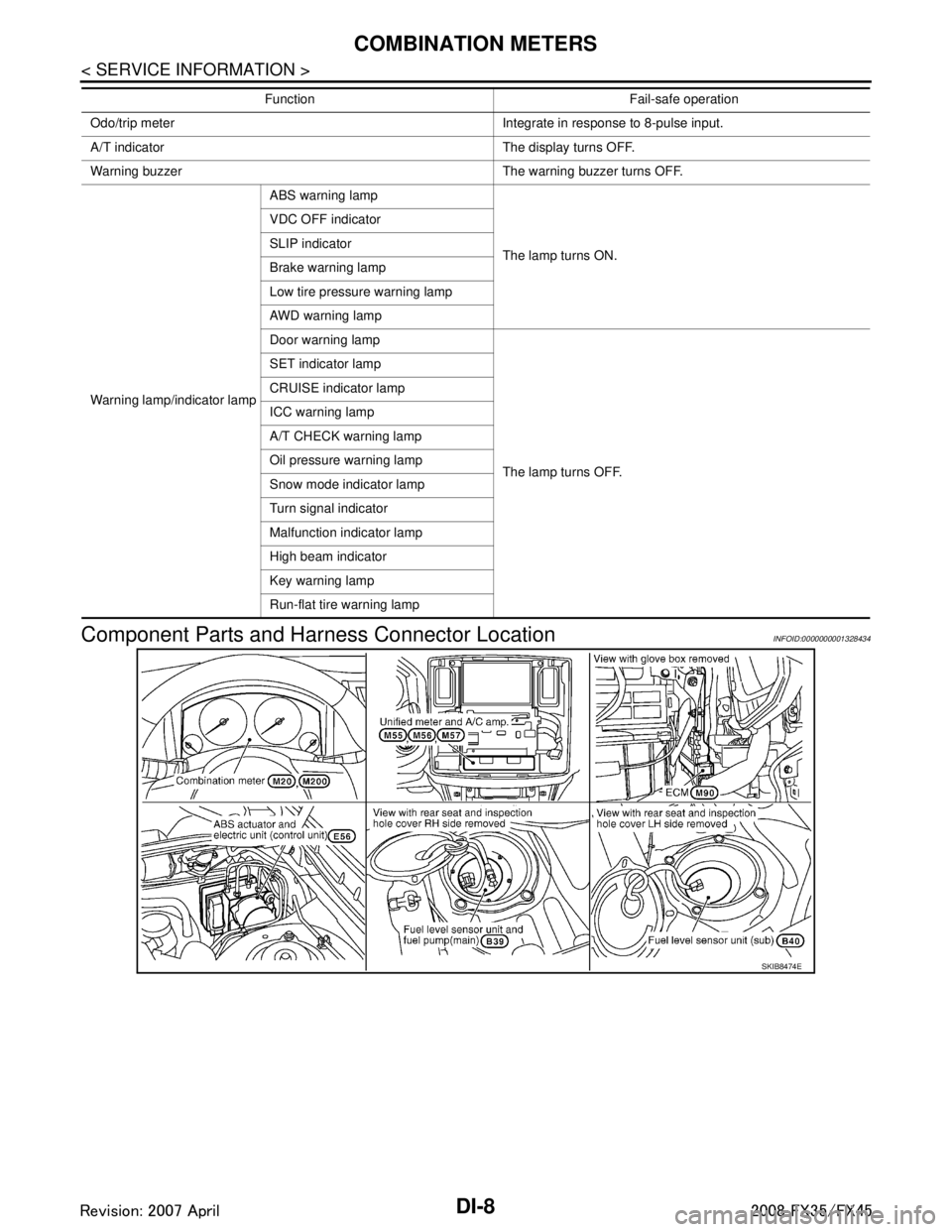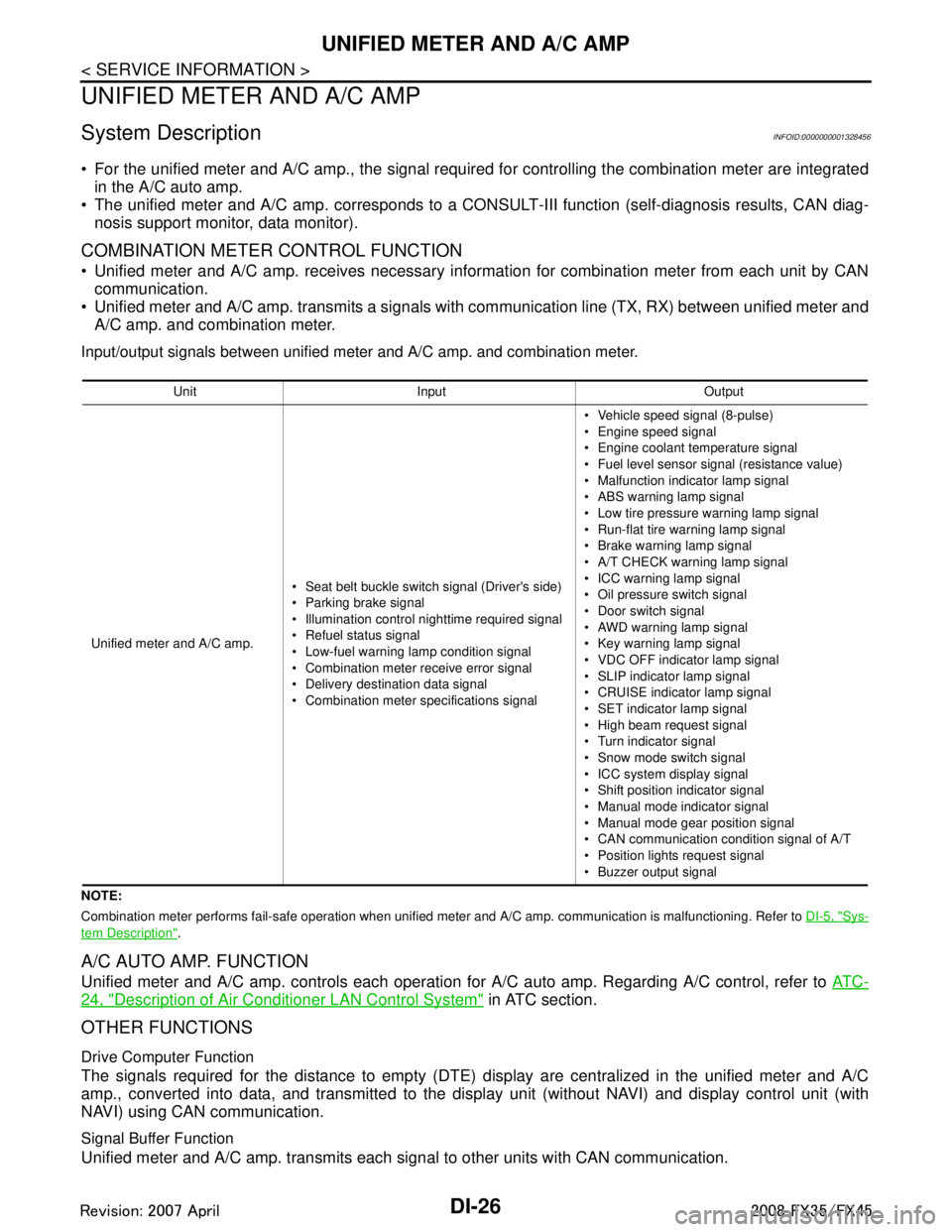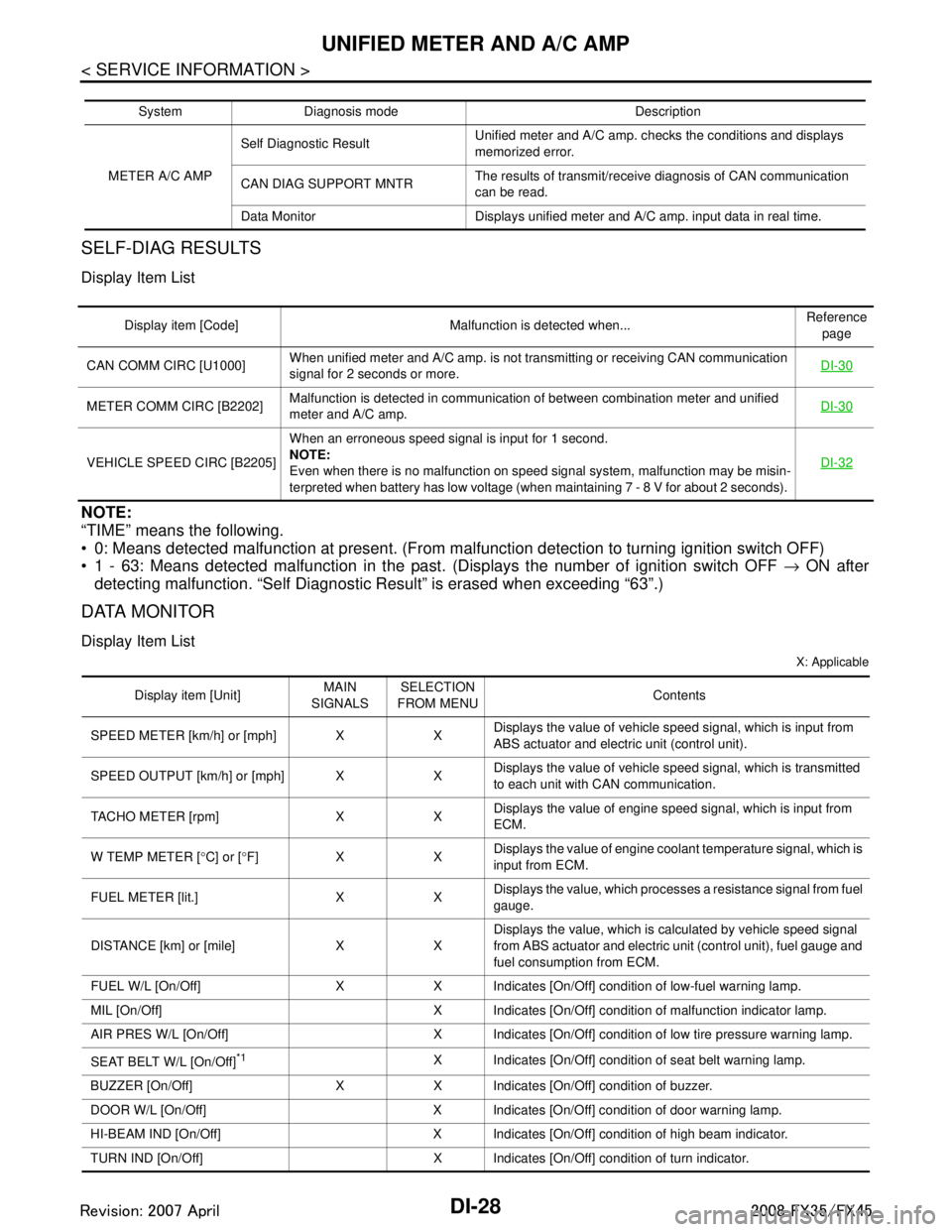2008 INFINITI FX35 low beam
[x] Cancel search: low beamPage 43 of 3924
![INFINITI FX35 2008 Service Manual
ACS-36
< SERVICE INFORMATION >[ICC]
TROUBLE DIAGNOSIS FOR
SELF-DIAGNOSTIC ITEMS
DTC 11 CONTROL UNIT
INFOID:0000000001328826
1.PERFORM SELF-DIAGNOSIS OF ICC SYSTEM
1. Perform self-diagnosis of ICC sy INFINITI FX35 2008 Service Manual
ACS-36
< SERVICE INFORMATION >[ICC]
TROUBLE DIAGNOSIS FOR
SELF-DIAGNOSTIC ITEMS
DTC 11 CONTROL UNIT
INFOID:0000000001328826
1.PERFORM SELF-DIAGNOSIS OF ICC SYSTEM
1. Perform self-diagnosis of ICC sy](/manual-img/42/57017/w960_57017-42.png)
ACS-36
< SERVICE INFORMATION >[ICC]
TROUBLE DIAGNOSIS FOR
SELF-DIAGNOSTIC ITEMS
DTC 11 CONTROL UNIT
INFOID:0000000001328826
1.PERFORM SELF-DIAGNOSIS OF ICC SYSTEM
1. Perform self-diagnosis of ICC system.
2. Check if any item other than “DTC 11 CONTRO L UNIT” is indicated on self-diagnosis display.
Is any indicated?
YES >> 1. Repair or replace applicable item. 2. Erase DTC and perform ICC system running test. Then perform self-diagnosis of ICC system
again.
NO >> 1. Replace ICC unit.
2. Erase DTC and perform ICC system running test. Then perform self-diagnosis of ICC system
again.
DTC 20 CAN COMM CIRCUITINFOID:0000000001328827
1.PERFORM SELF-DIAGNOSIS OF ICC SYSTEM
1. Turn ignition switch ON and wait for 2 second or more.
2. Check self-diagnosis of ICC system.
Is
“CAN COMM CIRCUIT” displayed?
YES >> Refer to LAN-14, "Trouble Diagnosis Flow Chart".
NO >> Refer to GI-35, "
CONSULT-III/GST Data Link Connector (DLC) Circuit".
92 ECM CIRCUIT ×××× ECM malfunction
Accelerator pedal position sensor
malfunction
ICC unit malfunction ACS-50
96 NP RANGE
××× Park/neutral position switch har-
ness is open or shorted.
Park/neutral position switch mal- function.
TCM malfunction ACS-51
97 AT CIRCUIT
××× TCM malfunctionACS-52
98 GEAR POSITION ××× TCM malfunction
AT turbine revolution sensor mal-
function
AT vehicle speed sensor malfunc-
tion ACS-52
102 RADAR STAIN
×× × ICC sensor body window has con-
tamination. ACS-53
103 LASER SENSOR FAIL
×× × ICC sensor internal malfunctionACS-53
104 LASER AIMING INCMP ×× × Laser beam aiming of ICC sensor
is not adjusted. ACS-54
107 LASER COMM FAIL
×× × CAN data received by ICC sensor
is strange (from ICC unit, combina-
tion meter or ECM). ACS-54
109 LASER HIGH TEMP
×× × Temperature around ICC sensor is
excessively high. ACS-54
DTC
No. CONSULT-III
screen terms ICC
system
warning lamp Fail-safe
Malfunctions detected where... Refer-
ence
page
Vehicle-
to-
vehicle
distance control mode Conven-
tional
(fixed
speed) cruise
control mode Brake as-
sist (with
preview
function)
3AA93ABC3ACD3AC03ACA3AC03AC63AC53A913A773A893A873A873A8E3A773A983AC73AC93AC03AC3
3A893A873A873A8F3A773A9D3AAF3A8A3A8C3A863A9D3AAF3A8B3A8C
Page 1134 of 3924

DI-8
< SERVICE INFORMATION >
COMBINATION METERS
Component Parts and Harn ess Connector Location
INFOID:0000000001328434
Odo/trip meter Integrate in response to 8-pulse input.
A/T indicator The display turns OFF.
Warning buzzer The warning buzzer turns OFF.
Warning lamp/indicator lamp ABS warning lamp
The lamp turns ON.
VDC OFF indicator
SLIP indicator
Brake warning lamp
Low tire pressure warning lamp
AWD warning lamp
Door warning lamp
The lamp turns OFF.
SET indicator lamp
CRUISE indicator lamp
ICC warning lamp
A/T CHECK warning lamp
Oil pressure warning lamp
Snow mode indicator lamp
Turn signal indicator
Malfunction indicator lamp
High beam indicator
Key warning lamp
Run-flat tire warning lamp
Function Fail-safe operation
SKIB8474E
3AA93ABC3ACD3AC03ACA3AC03AC63AC53A913A773A893A873A873A8E3A773A983AC73AC93AC03AC3
3A893A873A873A8F3A773A9D3AAF3A8A3A8C3A863A9D3AAF3A8B3A8C
Page 1152 of 3924

DI-26
< SERVICE INFORMATION >
UNIFIED METER AND A/C AMP
UNIFIED METER AND A/C AMP
System DescriptionINFOID:0000000001328456
For the unified meter and A/C amp., the signal required for controlling the combination meter are integrated
in the A/C auto amp.
The unified meter and A/C amp. corresponds to a CONS ULT-III function (self-diagnosis results, CAN diag-
nosis support monitor, data monitor).
COMBINATION METER CONTROL FUNCTION
Unified meter and A/C amp. receives necessary information for combination meter from each unit by CAN communication.
Unified meter and A/C amp. transmits a signals with communication line (TX, RX) between unified meter and A/C amp. and combination meter.
Input/output signals between unified meter and A/C amp. and combination meter.
NOTE:
Combination meter performs fail-safe operation when unified meter and A/C amp. communication is malfunctioning. Refer to DI-5, "
Sys-
tem Description".
A/C AUTO AMP. FUNCTION
Unified meter and A/C amp. controls each operation for A/C auto amp. Regarding A/C control, refer to AT C -
24, "Description of Air Conditioner LAN Control System" in ATC section.
OTHER FUNCTIONS
Drive Computer Function
The signals required for the distance to empty (DTE) display are centralized in the unified meter and A/C
amp., converted into data, and transmitted to the disp lay unit (without NAVI) and display control unit (with
NAVI) using CAN communication.
Signal Buffer Function
Unified meter and A/C amp. transmits each signal to other units with CAN communication.
Unit Input Output
Unified meter and A/C amp. Seat belt buckle switch signal (Driver's side)
Parking brake signal
Illumination control nighttime required signal
Refuel status signal
Low-fuel warning lamp condition signal
Combination meter receive error signal
Delivery destination data signal
Combination meter specifications signal Vehicle speed signal (8-pulse)
Engine speed signal
Engine coolant temperature signal
Fuel level sensor signal (resistance value)
Malfunction indicator lamp signal
ABS warning lamp signal
Low tire pressure warning lamp signal
Run-flat tire wa
rning lamp signal
Brake warning lamp signal
A/T CHECK warning lamp signal
ICC warning lamp signal
Oil pressure switch signal
Door switch signal
AWD warning lamp signal
Key warning lamp signal
VDC OFF indicator lamp signal
SLIP indicator lamp signal
CRUISE indicator lamp signal
SET indicator lamp signal
High beam request signal
Turn indicator signal
Snow mode switch signal
ICC system display signal
Shift position indicator signal
Manual mode indicator signal
Manual mode gear position signal
CAN communication condition signal of A/T
Position lights request signal
Buzzer output signal
3AA93ABC3ACD3AC03ACA3AC03AC63AC53A913A773A893A873A873A8E3A773A983AC73AC93AC03AC3
3A893A873A873A8F3A773A9D3AAF3A8A3A8C3A863A9D3AAF3A8B3A8C
Page 1154 of 3924

DI-28
< SERVICE INFORMATION >
UNIFIED METER AND A/C AMP
SELF-DIAG RESULTS
Display Item List
NOTE:
“TIME” means the following.
0: Means detected malfunction at present. (From malfunction detection to turning ignition switch OFF)
1 - 63: Means detected malfunction in the past . (Displays the number of ignition switch OFF → ON after
detecting malfunction. “Self Diagnostic Result” is erased when exceeding “63”.)
DATA MONITOR
Display Item List
X: Applicable
System Diagnosis mode Description
METER A/C AMP Self Diagnostic Result
Unified meter and A/C amp. checks the conditions and displays
memorized error.
CAN DIAG SUPPORT MNTR The results of transmit/receive diagnosis of CAN communication
can be read.
Data Monitor Displays unified meter and A/C amp. input data in real time.
Display item [Code] Malfunction is detected when... Reference
page
CAN COMM CIRC [U1000] When unified meter and A/C amp. is not transmitting or receiving CAN communication
signal for 2 seconds or more. DI-30
METER COMM CIRC [B2202]Malfunction is detected in communication of between combination meter and unified
meter and A/C amp.
DI-30
VEHICLE SPEED CIRC [B2205]When an erroneous speed signal is input for 1 second.
NOTE:
Even when there is no malfunction on speed signal system, malfunction may be misin-
terpreted when battery has low voltage (when maintaining 7 - 8 V for about 2 seconds). DI-32
Display item [Unit]
MAIN
SIGNALS SELECTION
FROM MENU Contents
SPEED METER [km/h] or [mph] X X Displays the value of vehicle speed signal, which is input from
ABS actuator and electric unit (control unit).
SPEED OUTPUT [km/h] or [mph] X X Displays the value of vehicle speed signal, which is transmitted
to each unit with CAN communication.
TACHO METER [rpm] X X Displays the value of engine speed signal, which is input from
ECM.
W TEMP METER [ °C] or [ °F] X X Displays the value of engine coolant temperature signal, which is
input from ECM.
FUEL METER [lit.] X X Displays the value, which processes a resistance signal from fuel
gauge.
DISTANCE [km] or [mile] X X Displays the value, which is calculated by vehicle speed signal
from ABS actuator and electric unit
(control unit), fuel gauge and
fuel consumption from ECM.
FUEL W/L [On/Off] X X Indicates [On/Off] condition of low-fuel warning lamp.
MIL [On/Off] X Indicates [On/Off] condition of malfunction indicator lamp.
AIR PRES W/L [On/Off] X Indicates [On/Off] condition of low tire pressure warning lamp.
SEAT BELT W/L [On/Off]
*1X Indicates [On/Off] condition of seat belt warning lamp.
BUZZER [On/Off] X X Indicates [On/Off] condition of buzzer.
DOOR W/L [On/Off] X Indicates [On/Off] condition of door warning lamp.
HI-BEAM IND [On/Off] X Indicates [On/Off] condition of high beam indicator.
TURN IND [On/Off] X Indicates [On/Off] condition of turn indicator.
3AA93ABC3ACD3AC03ACA3AC03AC63AC53A913A773A893A873A873A8E3A773A983AC73AC93AC03AC3
3A893A873A873A8F3A773A9D3AAF3A8A3A8C3A863A9D3AAF3A8B3A8C
Page 2610 of 3924
![INFINITI FX35 2008 Service Manual
EM-126
< SERVICE INFORMATION >[VQ35DE]
CYLINDER BLOCK
10. Remove pilot converter using the pilot bushing puller (SST) as
necessary.
11. Remove rear oil seal retainer. Remove by inserting a screwdri INFINITI FX35 2008 Service Manual
EM-126
< SERVICE INFORMATION >[VQ35DE]
CYLINDER BLOCK
10. Remove pilot converter using the pilot bushing puller (SST) as
necessary.
11. Remove rear oil seal retainer. Remove by inserting a screwdri](/manual-img/42/57017/w960_57017-2609.png)
EM-126
< SERVICE INFORMATION >[VQ35DE]
CYLINDER BLOCK
10. Remove pilot converter using the pilot bushing puller (SST) as
necessary.
11. Remove rear oil seal retainer. Remove by inserting a screwdriver between main bearing cap and rear oil seal retainer.
CAUTION:
If rear oil seal retainer is removed, replace it with new one.
NOTE:
Regard both rear oil seal and retainer as an assembly.
12. Remove baffle plate from main bearing beam (2WD models).
13. Remove piston and connecting rod assembly with the following procedure: Before removing piston and connecting rod assembly, check the connecting rod side clearance. Refer to
EM-138, "
Inspection After Disassembly".
CAUTION:
Be careful not to drop connecting ro d bearing, and to scratch the surface.
a. Position crankshaft pin corresponding to connecting rod to be removed onto the bottom dead center.
b. Remove connecting rod bearing cap.
c. Using a hammer handle or similar tool, push piston and connect- ing rod assembly out to the cylinder head side.
CAUTION:
Be careful not to damage the cylinder wall and crankshaft
pin, resulting from an interf erence of the connecting rod big
end.
14. Remove connecting rod bearings from connecting rod and connecting rod bearing cap. CAUTION:
Be careful not to drop connecting ro d bearing, and to scratch the surface.
Identify installation positions, and store them without mixing them up.
15. Remove piston rings form piston. Before removing piston rings, check the piston ring side clearance. Refer to EM-138, "
Inspection After
Disassembly".
Use a piston ring expander (commercial service tool).
CAUTION:
When removing piston rings, be careful not to damage piston.
Be careful not to damage piston rings by expanding them
excessively.
16. Remove piston from connecting rod as follows:
SEM005G
EMQ0191D
PBIC0087E
3AA93ABC3ACD3AC03ACA3AC03AC63AC53A913A773A893A873A873A8E3A773A983AC73AC93AC03AC3
3A893A873A873A8F3A773A9D3AAF3A8A3A8C3A863A9D3AAF3A8B3A8C
Page 2612 of 3924
![INFINITI FX35 2008 Service Manual
EM-128
< SERVICE INFORMATION >[VQ35DE]
CYLINDER BLOCK
18. Remove main bearing beam.
19. Remove main bearing caps.
CAUTION:
Be careful not to drop main b earing, and to scratch the sur-
face.
Using INFINITI FX35 2008 Service Manual
EM-128
< SERVICE INFORMATION >[VQ35DE]
CYLINDER BLOCK
18. Remove main bearing beam.
19. Remove main bearing caps.
CAUTION:
Be careful not to drop main b earing, and to scratch the sur-
face.
Using](/manual-img/42/57017/w960_57017-2611.png)
EM-128
< SERVICE INFORMATION >[VQ35DE]
CYLINDER BLOCK
18. Remove main bearing beam.
19. Remove main bearing caps.
CAUTION:
Be careful not to drop main b earing, and to scratch the sur-
face.
Using main bearing cap bolts, remove main bearing cap while shaking it back-and-forth.
20. Remove crankshaft.
21. Remove main bearings and thrust bearings from cylinder block and main bearing caps. CAUTION:
Be careful not to drop main b earing, and to scratch the surface.
Identify installation positions, and store them without mixing them up.
22. Remove oil jet.
ASSEMBLY
1. Fully air-blow engine coolant and engine oil passages in cylinder block, cylinder bore and crankcase to
remove any foreign material.
CAUTION:
Use a goggles to protect your eye.
2. Install each plug to cylinder block as shown in the figure. Apply sealant to the thread of water drain plugs “A”, “B” and
“C”.
Use Genuine RTV Silicone Seal ant or equivalent. Refer to
GI-44, "
Recommended Chemical Product and Sealant".
Apply sealant to the thread of plugs “D” and “E”. Use Genuine High Strength Thread Locking Sealant or
equivalent. Refer to GI-44, "
Recommended Chemical
Product and Sealant".
Apply sealant to the thread of plug “F”. Use Anaerobic Liquid Gasket or equivalent. Refer to GI-
44, "Recommended Chemical Product and Sealant".
NOTE:
For Canada, “F” in the figure is not plug but block heater. Refer
to EM-122, "
Component".
Replace washers with new one.
PBIC0881E
EMQ0195D
PBIC2610E
3AA93ABC3ACD3AC03ACA3AC03AC63AC53A913A773A893A873A873A8E3A773A983AC73AC93AC03AC3
3A893A873A873A8F3A773A9D3AAF3A8A3A8C3A863A9D3AAF3A8B3A8C
Page 2614 of 3924
![INFINITI FX35 2008 Service Manual
EM-130
< SERVICE INFORMATION >[VQ35DE]
CYLINDER BLOCK
Main bearing caps are identified by identification mark cast on
them. For installation, face front mark to front side.
NOTE:
Main bearing cap c INFINITI FX35 2008 Service Manual
EM-130
< SERVICE INFORMATION >[VQ35DE]
CYLINDER BLOCK
Main bearing caps are identified by identification mark cast on
them. For installation, face front mark to front side.
NOTE:
Main bearing cap c](/manual-img/42/57017/w960_57017-2613.png)
EM-130
< SERVICE INFORMATION >[VQ35DE]
CYLINDER BLOCK
Main bearing caps are identified by identification mark cast on
them. For installation, face front mark to front side.
NOTE:
Main bearing cap cannot be replaced as a single part, because it
is machined together with cylinder block.
7. Install main bearing beam. Install main bearing beam with front mark facing downward (oil pan side).
Install main bearing beam with front mark facing front of the
engine.
8. Install main bearing cap bolts in numerical order as shown in the figure as follows:
a. Inspect the outer diameter of main bearing cap bolt. Refer to EM-138, "
Inspection After Disassembly".
b. Apply new engine oil to threads and seat surfaces of main bear- ing cap bolts.
c. Tighten main bearing cap bolts in several different steps.
d. Turn all main bearing cap bolts 90 degrees clockwise (Angle tightening).
CAUTION:
Use the angle wrench [SST: KV10112100 (BT8653-A)] to
check tightening angle. Do not make judgment by visual
inspection.
After installing main bearing cap bolts, make sure that crank-
shaft can be rotated smoothly by hand.
Check the crankshaft end play. Refer to EM-138, "
Inspection
After Disassembly".
9. Install piston to connecting rod as follows:
a. Using a snap ring pliers, install new snap ring to the groove of piston rear side. Insert it fully into groove to install.
b. Install piston to connecting rod. Using an industrial use drier or similar tool, heat piston until piston pin can be pushed in by hand without
excess force [approx. 60 to 70 °C (140 to 158 °F)]. From the front to the rear, insert piston pin into piston
and connecting rod.
SEM456G
PBIC0881E
: 35.3 N·m (3.6 kg-m, 26 ft-lb)
PBIC1800E
PBIC0921E
3AA93ABC3ACD3AC03ACA3AC03AC63AC53A913A773A893A873A873A8E3A773A983AC73AC93AC03AC3
3A893A873A873A8F3A773A9D3AAF3A8A3A8C3A863A9D3AAF3A8B3A8C
Page 2628 of 3924
![INFINITI FX35 2008 Service Manual
EM-144
< SERVICE INFORMATION >[VQ35DE]
CYLINDER BLOCK
Measure the outer diameter of
piston skirt with a micrometer.
Piston-to-Cylinder Bore Clearance
Calculate by piston skirt diameter and cylinder INFINITI FX35 2008 Service Manual
EM-144
< SERVICE INFORMATION >[VQ35DE]
CYLINDER BLOCK
Measure the outer diameter of
piston skirt with a micrometer.
Piston-to-Cylinder Bore Clearance
Calculate by piston skirt diameter and cylinder](/manual-img/42/57017/w960_57017-2627.png)
EM-144
< SERVICE INFORMATION >[VQ35DE]
CYLINDER BLOCK
Measure the outer diameter of
piston skirt with a micrometer.
Piston-to-Cylinder Bore Clearance
Calculate by piston skirt diameter and cylinder bor e inner diameter (direction “Y”, position “B”).
(Clearance) = (Cylinder bore inner diameter) – (Piston skirt diameter).
If the calculated value exceeds the limit, replace piston and piston pin assembly. Refer to EM-134, "
How to
Select Piston and Bearing".
Re-boring Cylinder Bore
1. Cylinder bore size is determined by adding piston to cylinder bore clearance to piston skirt diameter.
2. Install main bearing caps and main bearing beam, and tighten to the specified torque. Otherwise, cylinder bores may be distorted in final assembly.
3. Cut cylinder bores. NOTE:
When any cylinder needs boring, all other cylinders must also be bored.
Do not cut too much out of cylinder bore at a time. Cut only 0.05 mm (0.0020 in) or so in diameter at a
time.
4. Hone cylinders to obtain the specified piston to cylinder bore clearance.
5. Measure finished cylinder bore for the out-of-round and taper. NOTE:
Measurement should be done after cylinder bore cools down.
CRANKSHAFT MAIN JOURNAL DIAMETER
Measure the outer diameter of cranks haft main journals with a micrometer.
If out of the standard, measure t he main bearing oil clearance. Then use undersize bearing. Refer to "MAIN
BEARING OIL CLEARANCE".
CRANKSHAFT PIN JOURNAL DIAMETER
Measure point
: Distance from the top 41.0 mm (1.614 in)
Standard : 95.480 - 95.510 mm (3.7590 - 3.7602 in)
PBIC0125E
Standard : 0.010 - 0.030 mm (0.0004 - 0.0012 in)
Limit : 0.08 mm (0.0031 in)
Re-bored size calculation: D = A + B – C
where,D: Bored diameter
A: Piston skirt diameter as measured
B: Piston to cylinder bore clearance (standard value)
C: Honing allowance 0.02 mm (0.0008 in)
Standard : 59.951 - 59.975 mm (2.3603 - 2.3612 in) dia.
3AA93ABC3ACD3AC03ACA3AC03AC63AC53A913A773A893A873A873A8E3A773A983AC73AC93AC03AC3
3A893A873A873A8F3A773A9D3AAF3A8A3A8C3A863A9D3AAF3A8B3A8C